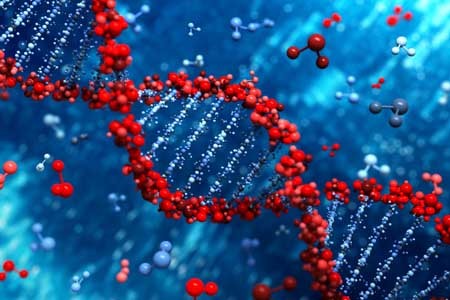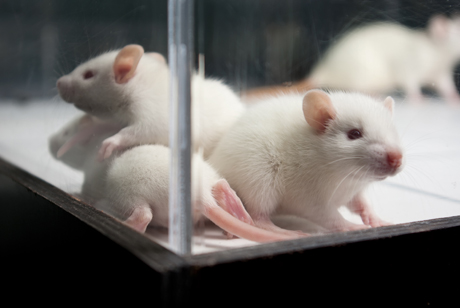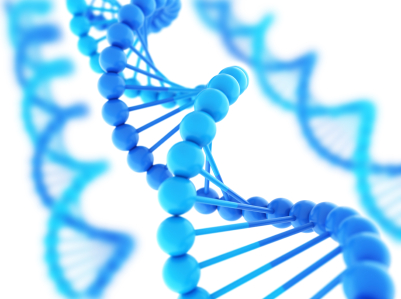DNA Repair Plays Role in Brain Development, Cancer, and Aging
DNA has several ways of repairing itself. Serious damage, including breaks to both strands of the double helix and problems with replication, prompt a process known as DNA damage repair, or DDR. Researcher Stephen J. Elledge of Harvard Medical School won the 2015 Albert Lasker Basic Medical Research Award for his findings about DDR. He summarized these findings in a September article in the journal JAMA.
DDR occurs because of DNA’s remarkable self-awareness. Through the DDR process, DNA can detect when it has been damaged and prompt the right kind of repair. When damage occurs, DDR allows for the activation of enzymes that can remodel DNA to maintain the integrity of the genome.
When DDR pathways are activated, they can alter more than 1000 different proteins. DDR can affect immune function, blood and bone marrow, viral response, cancer, aging, and brain development.
Mutations in components of the DDR pathway can lead to problems with brain development, including Seckel syndrome (characterized by dwarfism, brain and facial abnormalities, and mental retardation) and ataxia telangiectasia (loss of control of bodily movements along with weakened immune system).
DDR is particularly relevant to cancer, since properly functioning DDR promotes a stable genome. Classic cancer treatments such as radiation and chemotherapy also rely on DDR to prompt cell death.
DDR also plays a role in aging. When we get older or have certain illnesses, telomeres, bits of material at the end of DNA strands that protect the DNA during replication, get shorter. This prompts DDR to engage in tumor prevention measures, either killing off the cells or changing them into what’s called senescent cells. Senescent cells prevent tumors, but their accumulation is associated with chronic inflammation, aging, and age-related diseases.
Editor’s Note: You can protect your telomeres and possibly hold off the age-related effects of DDR. Healthy diet, exercise, meditation, goal setting, and making positive contributions to society all help maintain telomere length. Lithium treatment also directly increases telomere length.
Childhood Adversity, Gene Methylation, and Internalizing Behaviors Linked
Life experiences such as adversity in childhood have been linked to epigenetic changes to DNA. These changes do not affect the sequence of DNA, but can change how tightly DNA is wound, and thus how easily it is transcribed. One epigenetic change that can occur following adversity in childhood is methylation of the gene for the glucocorticoid receptor (NR3C1). A recent study by Kathryn Ridout and colleagues examined links between early adversity, methylation of this gene, and behavioral problems in childhood. Adversity was linked to methylation of the gene at exons 1D and 1F in the promoter of NR3C1. Methylation of the gene was associated with internalizing behaviors (e.g. depression, anxiety) but not externalizing behaviors (e.g. attention deficit hyperactivity disorder (ADHD) or oppositional defiant disorder) in children of preschool age. The NR3C1 methylation was a significant mediator of the internalizing behaviors in children who had experienced adversity.
Editor’s Note: Similar associations of methylation of the glucocorticoid receptor with childhood adversity have been reported in other clinical and animal studies and provide a mechanism for the long-lasting adverse effects of stressors in childhood.
Transgenerational Transmission of Drug Exposure and Stress in Rodents
New data suggest that there can be transgenerational transmission of the effects of drug exposure and stress from a paternal rat to its offspring. The father mates with a female who was not exposed to drugs or stress and never has any contact with the offspring. Consensus is now building that this transmission occurs via epigenetic alterations in sperm.
Epigenetic alterations are those that are mediated by chemical changes in the structure of DNA and of the histones around which DNA is wrapped. These changes do not alter the inherited gene sequences but only alter how easy it is for genes encoded in the DNA to be activated (transcribed) or suppressed (inhibited).
There are three common types of epigenetic modifications. One involves the attachment of a methyl or acetyl group to the N-terminals of histones. Methylation typically inhibits transcription while acetylation activates transcription. Histones can also be altered by the addition of other compounds. The second major type of epigenetic change is when the DNA itself is methylated. This usually results in inhibition of the transcription of genes in that area. The third epigenetic mechanism is when microRNA (miRNA) binds to active RNA and changes the degree to which proteins are synthesized.
At a recent scientific meeting, researchers described the various ways epigenetic changes can be passed on to future generations.
Researcher Chris Pierce reported that chronic cocaine administration increased brain-derived neurotrophic factor (BDNF) in the medial prefrontal cortex of rats. (BDNF is important for learning and memory.) The cocaine administration led to acetylation of the promoter for BDNF.
This exposure to cocaine in male rats who then fathered offspring led to two changes in the offspring, presumably conveyed by epigenetic changes to the fathers’ sperm. The first change was a decrease in cocaine reinforcement. The offspring took longer to acquire a cocaine self-administration habit. The second change was long-lasting learning deficits in the male offspring, specifically recognition of novel objects. The deficit was associated with a reduction in long-term potentiation in the offspring. Long-term potentiation is the strengthening of synapses that occurs through repeated patterns of activity. Surprisingly, the following generation also showed deficits in learning and memory, but did not show a loss of long-term potentiation.
Editor’s Note: These data indicate that alterations in sensitivity to cocaine (in this case slower acquisition of cocaine self-administration) can be transferred to a later generation, as can learning deficits in males. These data suggest that fathers’ experience of drugs can influence cocaine responsiveness and learning via epigenetic mechanisms likely mediated via epigenetic changes to the father’s sperm.
This research suggests the possibility that, in a human clinical situation, there would be three ways that a father’s drug abuse could affect his child’s DNA. First, there is the traditional genetic inheritance, where, for example, an increased risk for drug abuse is passed on to the child via the father’s genetic code. Next, drug abuse brings about epigenetic changes to the father’s sperm. (His genetic code remains the same, but acetyl groups attach to the BDNF promoter section of his DNA, changing how those proteins get produced.) Lastly, if the father’s drug abuse added stress to the family environment, this stress could have epigenetic effects on the child’s DNA.
Researcher Alison Rodgers described how epigenetic changes involving miRNA in paternal rats influence endocrine responsivity to stress in their offspring. Rodgers put rats under stress and observed a decrease in hormonal corticosterone response to stress. When a father rat was stressed, nine different miRNAs were altered in its sperm. To prove that this stress response could be passed on transgenerationally via miRNAs, the researchers took sperm from an unstressed father, loaded it with one or all nine miRNAs from the stressed animal, and artificially inseminated female rats. Rodgers found that the sperm containing all nine miRNAs, but not the sperm carrying one randomly selected miRNA, resulted in offspring with a blunted corticosterone response to stress.
Researcher Eric Nestler showed that when a rodent goes through 10 days of defeat stress (being defeated repeatedly by a larger animal), they begin to exhibit behaviors resembling those seen in depression. Social avoidance was the most robust change, and continued for the rest of the animal’s life. Animals did not have to be physically attacked by the bigger animal to show the depression-like effects of defeat stress. Just witnessing the repeated defeats of another rat was sufficient to produce the syndrome. Again, father rats that experienced defeat stress or witnessed it passed this susceptibility to defeat stress on to their offspring (with whom they never had any contact), likely by epigenetic changes to sperm. Read more
Exercise Helps Mice with Spacial Learning
Exercise increases brain-derived neurotrophic factor (BDNF), a protein that protects neurons and is important for learning and memory. In a study of mice who were trained to find objects, sedentary mice could not discriminate between familiar object locations and novel ones 24 hours after receiving weak training, while mice who had voluntarily taken part in exercise over a 3-week period could easily distinguish between these locations after the weak training.
Mice who received sodium butyrate (NaB) after training behaved similarly well to those who had exercised. Sodium butyrate is a histone deacetylase (HDAC) inhibitor, meaning it helps keep acetyl groups on histones, around which DNA is wrapped, making the DNA easier to transcribe. In this case the easy transcription of DNA enables learning under conditions in which it might not usually take place.
Both sodium butyrate and exercise promote learning through their effects on BDNF in the hippocampus. They make the DNA for BDNF easier to transcribe, suggesting that exercise can put the brain in a state of readiness to create new or more lasting memories.
Short Telomeres, More Depressions, and Risk of the Common Cold
 Too many depressions in unipolar and bipolar disorder are associated with multiple risks. These include social and employment losses, dysfunction and disability, cognitive dysfunction, reduction in hippocampal volume (in unipolar depression), increases in medical comorbidity, increased risk of cardiovascular disease, and endocrine abnormalities (see the 2012 article by this author Post et al. in the Journal of Psychiatric Research).
Too many depressions in unipolar and bipolar disorder are associated with multiple risks. These include social and employment losses, dysfunction and disability, cognitive dysfunction, reduction in hippocampal volume (in unipolar depression), increases in medical comorbidity, increased risk of cardiovascular disease, and endocrine abnormalities (see the 2012 article by this author Post et al. in the Journal of Psychiatric Research).
To this list we can now add short telomeres. Telomeres sit at the end of DNA strands and shorten with each cell replication. A person’s percentage of short telomeres increases with aging. The number of depressions a patient with bipolar II disorder has had is also associated with a higher percentage of short telomeres. The magnitude of the difference in telomeres is equivalent to 10 years of aging.
An article by Cohen et al. published by the Journal of the American Medical Association (JAMA) in 2013 suggests that short telomeres can even be linked to increased vulnerability to viral infections causing the common cold. Depression has also been linked to various immune deficiencies. Whether direct alteration in immune function is responsible or whether this is mediated via telomere length remains to be determined.
Editor’s Note: The moral of this story is that patients should stay on effective treatment long-term to prevent depression in the recurrent affective disorders. This means antidepressants for unipolar depression, and mood stabilizers and atypical antipsychotics for bipolar depression. Prevent depressions and protect your brain and your telomeres (and as a bonus, you may not get so many colds).
Telomere Length Important for Health
 Elizabeth Blackburn (who won the Nobel Prize for medicine in 2009) gave a spectacular plenary lecture at the 2013 meeting of the American Psychiatric Association, in which she described the role of telomeres in psychiatric and other medical disorders. Telomeres are the strands of DNA at the end of each chromosome that protect the integrity of the DNA each time the cell replicates. The end is capped to prevent damage, degeneration, and genetic instability. A minimum length must be maintained for the protection of the cells.
Elizabeth Blackburn (who won the Nobel Prize for medicine in 2009) gave a spectacular plenary lecture at the 2013 meeting of the American Psychiatric Association, in which she described the role of telomeres in psychiatric and other medical disorders. Telomeres are the strands of DNA at the end of each chromosome that protect the integrity of the DNA each time the cell replicates. The end is capped to prevent damage, degeneration, and genetic instability. A minimum length must be maintained for the protection of the cells.
Telomeres shorten with aging and with each cell replication. They also shorten as a function of childhood adversity, stressors in adulthood, and number of episodes of depression. When a cell’s telomeres get too short, the cell enters a period of senescence, meaning it no longer replicates. Senescence is associated with a variety of adverse events, including the possibility of apoptosis (cell death), pro-inflammatory effects, and pro-tumor effects. The cell can begin to resemble a rotten apple that spreads its ill effects to others nearby. These effects can predispose a person to diseases such as diabetes, depression, attention deficit hyperactivity disorder (ADHD), anxiety disorders, pulmonary fibrosis, aplastic anemia, cardiovascular disorders (stroke and heart attack), osteoarthritis, immune abnormalities, dementia (in women), and premature aging.
Certain lifestyle alterations can increase telomere length, such as mindfulness/yoga training, exercise, sleep, omega-3 fatty acids, and having a positive purpose or meaning in life. Telomeres can also be lengthened by a synthetic enzyme called telomerase.
Other lifestyle factors can shorten telomeres or make telomerase less effective. Chronic stress can decrease the activity of telomerase by 50%. For people serving as the caregiver of a loved one, the longer the duration of this stress, the shorter the length of telomeres. High levels of what Blackburn described as cynical hostility also decrease telomere length.
Editor’s Note: Here we have more evidence that stress can affect our genes. We have written before about epigenetics, the study of the process by which environmental events such as stress can leave behind methyl and acetyl groups on DNA and histones that affect how easily DNA is turned on or off. Now it seems that stress can also have profound effects on the telomeres that cap each strand of DNA and keep it stable. An overly high proportion of short chromosomes is associated with a range of psychiatric and medical illnesses. This type of non-hereditary influence on genes could mediate some of the long-term effects of the environment on health. The good news for patients with bipolar disorder is that M. Schalling et al. found that treatment with lithium lengthened telomeres. Perhaps the bottom line of this whole collection of fascinating data is: Take good care of your telomeres, and they will take care of you.
Lithium Extends Telomeres
 Telomeres sit at the ends of strands of DNA at each chromosome. Various events make telomeres decrease in length: cell division/replication, stress, aging, and depressive episodes in Bipolar II disorder.
Telomeres sit at the ends of strands of DNA at each chromosome. Various events make telomeres decrease in length: cell division/replication, stress, aging, and depressive episodes in Bipolar II disorder.
Martin Schalling, a professor of medical genetics at the Karolinska Institutet in Sweden, has found that lithium treatment lengthens telomeres.
Editor’s Note: This finding by Schalling, which will soon be published, adds to the list of beneficial neurobiological effects of lithium, including increasing cell survival factors BDNF and Bcl-2, decreasing cell death factors BAX and p53, increasing marker of neuronal integrity NAA, and possibly increasing hippocampal and cortical grey matter volumes.
Clinically, lithium decreases recurrence of manic and depressive episodes (mania more than depression), decreases suicidality, and may slow cognitive deterioration in those with mild cognitive impairment.
These clinical and neurobiological benefits to lithium treatment should be factored in to calculations of the risk/benefit ratio for lithium use in long-term preventative treatment of bipolar disorder.
Depression Associated with Increased DNA Methylation
Epigenetics is an emerging field where researchers are studying the ways environmental events and biochemical changes can affect the structure of DNA. Chemicals such as methyl groups can accumulate on DNA (a process called methylation), which usually results in suppression of genes in that area. DNA is tightly wound around proteins called histones, which can also be methylated or acetylated (when acetyl groups accumulate) based on events in the environment, including stressors and drug use. The environmental events do not change the genetic inheritance people receive from their parents, but instead change the ease with which genes are transcribed (or switched on).
At the 2012 meeting of the Society of Biological Psychiatry, Dr. Yurong Xin et al. presented an abstract that indicates that depressed patients may have much more DNA methylation at CpG sites on genes. CpG sites occur in many genes and refer to a place where a cytosine and a guanine (two of the four building blocks of DNA) sit next to each other on the same strand of DNA (the ‘p’ refers to the chemical bond between the two). CpG sites can become methylated. Xin and colleagues measured 27,578 CpG sites across 14,000 genes in the human genome. They found an eightfold increase in DNA methylation at these CpG sites in depressed patients compared to controls.
Editor’s Note: Previous research has found that early life experiences like psychosocial stress can lead to epigenetic changes. The new findings by Dr. Xin indicate that DNA methylation may occur and accumulate across the lifespan and suggests that DNA methylation may be associated with the emergence and progression of depression. Future treatments for depression could target this DNA hypermethylation, but determining how to do that selectively without affecting normal functioning may be a challenge.
How Illness Progresses In The Recurrent Affective Disorders
This editor (RM Post) in collaboration with Jacqueline Fleming and Flavio Kapczinski published the article “Neurobiological mechanisms of illness progression in the recurrent affective disorders” in the Journal of Psychiatric Research this year. The article built on several themes about the progression of bipolar illness that had been explored in previous research.
These themes include:
- The likely acceleration of repeated episodes as a function of the number of prior episodes (episode sensitization)
- The increased responsivity of the illness to repeated stressors (stress sensitization)
- The increased behavioral reactivity to repeated use of psychomotor stimulants such as cocaine (stimulant-induced behavioral sensitization)
Not only are these observations well documented in the scientific literature, but recent observations also suggest that each type of sensitization can show cross-sensitization to the other two types. That is, individuals exposed to repeated stressors are more likely both to experience affective illness episodes and to adopt comorbid substance abuse. In a similar way, episodes of an affective disorder and stressors may also be associated with the relapse into drug administration in those who have been abstinent.
In addition to these mechanisms of illness progression in the recurrent affective disorders, the new article reviews the literature showing that the number of affective episodes or the duration of the illness appear to be associated with a variety of other clinical and neurobiological variables.
The number of affective episodes a patient experiences is associated with the degree of cognitive dysfunction present in their bipolar illness, and experiencing more than 4 episodes of unipolar or bipolar depression is a risk factor for dementia in late life. A relative lack of response to most treatments is also correlated with the number of prior episodes, and this holds true for response to naturalistic treatment in general. While most of these data are correlational and the direction of causality cannot be ascertained for certain, it is likely that the number of affective episodes and/or their duration could account for and drive difficulties with treatment and with cognitive function.
If this were the case, one would expect to see a variety of neurobiological correlates with the number of prior episodes or duration of illness, and in the article we summarize those that have been found in unipolar and bipolar disorder. Considerable data indicate that cortical volume and degrees of prefrontal cortical dysfunction can vary as a function of number of prior episodes. There is evidence that increased activity of the amygdala and the nucleus accumbens are also related to episodes or duration of illness. In those with unipolar depression, the volume of the hippocampus is decreased with longer duration of illness. Read more
Environmental Influences on Gene Structure May Be Transmitted to Offspring
It has been thought that one fundamental principle of genetics is that the impact of environment factors cannot be passed from one generation to the next via the genetic code. New data suggest this may not be true.
In an emerging field called epigenetics, researchers are finding that while the impact of environment and life experiences is not registered in DNA sequences, environmental factors can influence the structure of DNA or tightness of its packaging. Early life experiences, particularly psychosocial stress, can lead to the accumulation of methyl groups on DNA (a process called methylation), which generally constricts DNA’s ability to start transcription (turning on) of genes and the synthesis of the proteins the genes encode. DNA is tightly wound around proteins called histones, which can also be methylated or acetylated based on events in the environment. When histones are acetylated, meaning that acetyl groups are attached to them, DNA is wound around them more loosely, facilitating gene transcription (i.e. the reading out of the DNA code into messenger RNA, which then arranges amino acids in order to construct proteins). Conversely, histone methylation usually tightens the winding of DNA and represses transcription.







